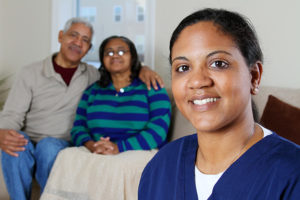New York’s CDPA Program –
Caring for Elderly Loved Ones
What is the CDPAP?
 CDPAP stands for the Consumer Directed Personal Assistance Program. The program is also referred to as the CDPAPNYS or the CDPA. This New York State Medicaid program allows chronically ill or physically disabled consumers who need help with everyday activities or skilled nursing to hire their home care assistants. Consumers can choose their caregivers, who may or may not be family members or friends. The primary benefit of the CDPAP model is that it gives people more control over who provides their care and how it is delivered. Rather than having a home health agency assign a stranger, patients can choose someone they trust. This concept is called consumer-directed care, though it is sometimes called participant direction, self-direction, or cash and counseling.
CDPAP stands for the Consumer Directed Personal Assistance Program. The program is also referred to as the CDPAPNYS or the CDPA. This New York State Medicaid program allows chronically ill or physically disabled consumers who need help with everyday activities or skilled nursing to hire their home care assistants. Consumers can choose their caregivers, who may or may not be family members or friends. The primary benefit of the CDPAP model is that it gives people more control over who provides their care and how it is delivered. Rather than having a home health agency assign a stranger, patients can choose someone they trust. This concept is called consumer-directed care, though it is sometimes called participant direction, self-direction, or cash and counseling.
While the patient gains control and cost savings through the Consumer Directed Personal Assistance Program (CDPAP), he or she also takes on specific responsibilities. The consumer or his or her representative assumes the responsibility for training, supervising, and terminating the caregivers, tasks that would otherwise be handled by the home care agency. The CDPAP may cover services typically provided by a personal care attendant, home health care aide, or a nurse, known as Consumer Directed Personal Assistance Services or CDPAS.
The purpose of the CDPA is to help those who have to leave a job to take care of a loved one who is disabled or chronically unwell. For example, an older person who needs daily assistance may be uncomfortable hiring a stranger to enter the home every day. Some medical tasks, such as giving injections, maybe outside the scope of a personal assistant. The CDPA allows the person to pay an adult child over the age of 21 or another trusted relative to provide care. The caregiver cannot be a spouse or legal guardian, but he or she may live in the home of the person they care for if the level of care required makes that necessary.
Is This for Family Only?
Here are some additional guidelines regarding who can serve as a personal care aid under the CDPAP:
- As of April 2016, the parents of a disabled adult child may serve as a CDPAP aide as long as they are not also the designated representative and do not live with the patient. (The designated representative is a person with legal decision-making authority for a person who is not able to self-direct.)
- An exception to the residence rule may be approved if the level of care requires it.
- A person who is not a citizen of the United States must have a valid work authorization to serve as an aide receiving payment through the CDPAP.
- While spouses cannot serve as paid aides through the CDPAP, ex-spouses, siblings, and adult children can perform in this role.
- Under the CDPAP, an aide does not have to be certified in any particular medical field. The patient and family teach the aide how to provide the care that is appropriate for the situation. An aide may carry out some skilled tasks that would usually be done by a nurse. For example, aides may give insulin injections, dispense medication, and administer oxygen if the patient cannot do these things for himself or herself.
How Do I Access the CDPAP?
To access the CDPA program, the individual needs an order from his or her physician or medical care provider. The referral goes to the social services district for a social and nursing assessment. The assessment must determine that the person can participate fully in the program and recommend a schedule for the services, including how often the caregiver will attend to the consumer, the length of each visit, and how long the services will continue.
A quarter-million New Yorkers receive assistance for long-term care through Medicaid, and two-thirds of them receive their care at home or in an assisted-living facility. All counties in New York state and all of the primary managed care and long-term care plans must include a provision for a CDPAP. These entities must notify eligible consumers of the availability of the program. Here are the criteria for eligibility:
- The patient must be eligible for Medicaid based on an evaluation of assets, income, and asset transfers history.
- The patient must qualify for home health services through a home care agency, private duty nursing, long-term home health care waiver, AIDS home care program, or personal care assistance program.
- The patient must have a stable medical condition that can be managed by a CDPAP aide.
- The patient must be a self-directing person or a non-self-directing person with a competent, designated representative who can participate in the care plan and its implementation.
Eligible persons participating in the CDPAP work with a caseworker and medical professional to establish a care plan, which outlines the care needed each week. Once the plan is approved, the patient and family hire, train, and supervise their providers.
What is a Self-Directing Person?
To participate fully in the CDPA/CDPAP, a consumer must be a self-directing person. This requirement exists because the consumer must hire, teach, monitor the caregivers, and line up alternative services if the caregiver is not available on a given day. The consumer must also keep up with documentation such as timesheets and payroll records for the caregiver. Here are the three main components indicative of a self-directing person.
- The consumer must be able and willing to make informed decisions about his or her lifestyle and the kind of care needed.
- The consumer must also be able to structure the home environment so that the care can be provided.
- The consumer must understand the consequences of hiring a personal assistant and the ability to take responsibility for the hiring process.
In the alternative, the consumer may have a competent representative who can make these decisions on his or her behalf. The representative does not have to be present at all times while care is delivered to a non-self-directing person.
What Does Medicaid Driven Program Mean?
The CDPA/CDPAP is a Medicaid driven program, which means that you must be enrolled in Medicaid to be eligible. If you don’t have Medicaid, but you feel you may be eligible, Trusted Choice Homecare can help you with the application process. The process can be intimidating, but help is available every step of the way.
For people covered by Medicaid only and not by Medicare, most are enrolled in a Mainstream Medicaid Managed Care plan that handles the authorization and management of CDPAP services. Clients covered by Medicare and Medicaid enroll in a Managed Long-Term Care plan to access CDPAP services, except in some specific circumstances.
How Trusted Choice Home Care Helps Set You Up for Success
 If you feel that you may qualify, let Trusted Choice Homecare help you navigate the assessments, forms, and other steps you must take. Trusted Choice has been a Fiscal Intermediary (FI) for the New York State CDPA since November of 2016. The FI role is different than that of a home health care agency. A home health assistant contracts with an FI who will pay the caregiver and the FI contracts with Medicaid for reimbursement. Most fiscal intermediaries are members of the CDPAANYS (Consumer Directed Personal Assistance Association of New York State).
If you feel that you may qualify, let Trusted Choice Homecare help you navigate the assessments, forms, and other steps you must take. Trusted Choice has been a Fiscal Intermediary (FI) for the New York State CDPA since November of 2016. The FI role is different than that of a home health care agency. A home health assistant contracts with an FI who will pay the caregiver and the FI contracts with Medicaid for reimbursement. Most fiscal intermediaries are members of the CDPAANYS (Consumer Directed Personal Assistance Association of New York State).
In the fiscal intermediary relationship, the aide does not work for the FI or a home care agency. Instead, the aide is an independent contractor, paid by the FI. The fiscal intermediary manages the processing of timesheets and payments. While the concept is relatively straight-forward, the implementation is complex, and many people are wrongly denied access to the program. Trusted Choice has the years of experience to make sure that you are not one of them.
At Trusted Choice Homecare, we work with most insurance companies, and we have long-standing relationships with the Department of Social Services’ local offices. We can help, even if you aren’t signed up for Medicaid yet. We have all the forms that you need, and we can help you gather all the relevant documentation. Contact us today online or call (716) 431-5550 to start the process to get the help you need to get back to your life.
Request Care: